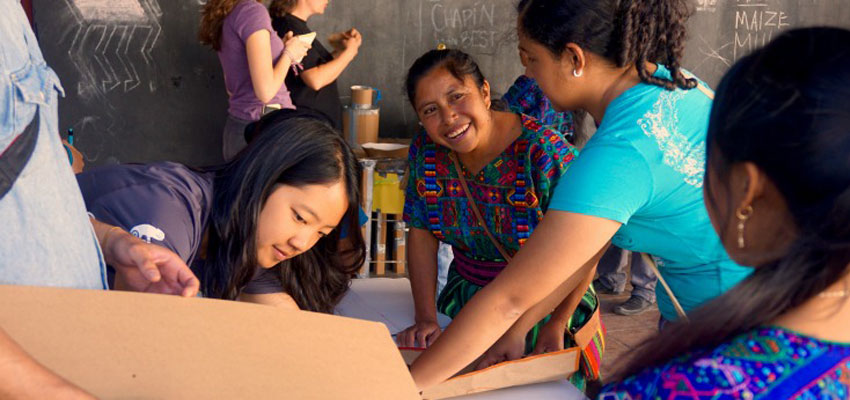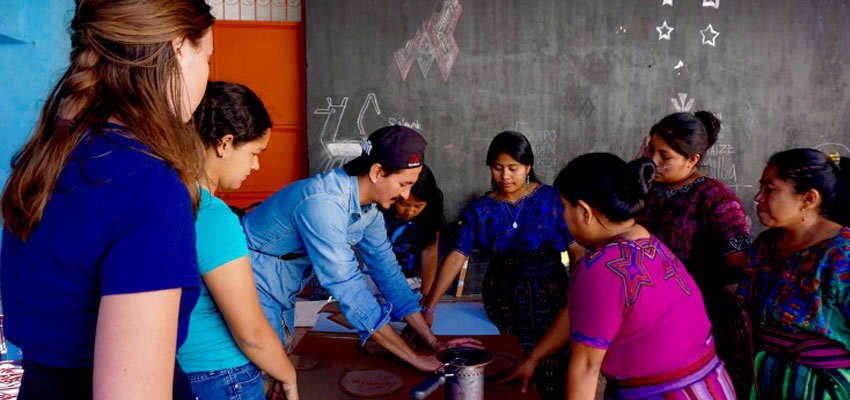
"The plancha served as a hub for the family, and was a source of joy. Its presence and value was something that we wanted to preserve in whatever we created. The importance of conserving traditional styles and cooking methods, and not disrupting traditional behavior was of primary importance to us."
In January 2018, a group of five D-Lab: Development students travelled to Santa Catarina, Guatemala to follow up on projects from IDDS sustainable homes, more specifically examine local cookstoves and cooking practices. Natalie Nicolas (MIT’18), Julia Cha (MIT’18), Cayanne Chachati (Harvard ‘20), Ghada Amer (Harvard ’20), and Neha Rajbhandary (Wellesley ’20) were accompanied by trip teader Charlotte Fagan for this trip. The team primarily collaborated with community partner Link4.
Santa Catarina, Palopo
After arriving in Guatemala City, our team left for our main location for the trip early in the morning the next day. We set out for Santa Catarina Palopo, which is a small scenic town on the banks of one of Guatemala’s most beautiful volcanic Lake’s: Lake Atitlan. On the banks of Lake Atitlan are small towns of indigenous Guatemalans, where each town has its own vibrant culture, tradition, and identity. This massive lake is surrounded by hills and towering volcanoes. Omar and Oscar, the co-founders of our community partner Link4 had good relations with the community in Santa Caterina after IDDS Sustainable Homes.

Immersion
We were introduced to the host families that we would be living with for the next two and a half weeks that we would be there. Our first week in Santa Caterina was almost spent entirely with our host families. This was the first stage of our entire project: information gathering, and cultural immersion. That entire week, our sleeping schedules had aligned with our host families. We woke up and slept the same time as them. We helped them prepare breakfast, lunch, and dinner, ate all three meals with them, and cleaned up after with them. Throughout the week, we tried to perfect our tortilla making skills.
We discovered that families use a number of cooking systems together, including open fires, the plancha or improved cookstove, and the gas stove. We observed their cooking styles, and asked them various questions to supplement the information we had gathered through observation. The main reason we engaged in this immersive process was because we were trying to modify a gasifier cookstove: a new cleaner burning technology primarily built for African countries. The modifications were necessary so that the current gasifier cookstove could easily accommodate the cooking styles and traditions of people living in Santa Caterina. We were realizing that technological change came with heavy implications. The plancha served as a hub for the family, and was a source of joy. Its presence and value was something that we wanted to preserve in whatever we created. The importance of conserving traditional styles and cooking methods, and not disrupting traditional behavior was of primary importance to us.

Observations and casual conversations alone didn’t seem like enough for us to start synthesizing information for our prototyping phase. To get more specific information regarding cooking habits, we conducted a workshop with a few local women using a storytelling cube: one of Link4’s creations. We also conducted short surveys with a variety of people in Santa Caterina. To get more information, we also had a few interactive posts set up in the town square.
Prototyping

After the collection process, we synthesized the information to find three key characteristics that the cookstove we would design would need to have: it should be capable of making tortillas, cooking with multiple pots simultaneously, and keeping food warm. We then brainstormed ideas and sketches individually and in groups until we decided to address the needs by creating a pot skirt structure with an air diverter that would direct the heat generated to both a hot spot where you could put pots, a skirt where you could make tortillas, and a warming station where you could warm pots and tortillas. We then got to physically build this model out of metal and prototype our design at the UVF Altiplano campus in Solola. We also built the prototypes out of cardboard which we demonstrated alongside our actual gasifiers in an interactive workshop for the community to get feedback on our designs, as well as get the community’s ideal designs in terms of size and configuration.

We left Santa Catarina for Guatemala City for the last three days of the trip, during which we created an hour long final presentation describing D-Lab, our experience, and our project. We then presented for the students at UVG whose class will continue working with Link4 on the project.

Final Reflections
Leaving Santa Catarina after almost three weeks of intense immersion was difficult for us, because we felt like we had been fully welcomed into our host families homes. Engaging with the community for the project had made us really invested in both the community as well as the project. We left Santa Catarina with a better understanding of how co-creation worked beyond the classroom. Our time in Guatemala was filled with meaningful conversations, sunsets at the lake, coffee, and many tortillas that we got to share with people we enjoyed being around. We will forever be grateful to D-Lab, our community partner Link4, and UVG for their support and most importantly all of Santa Catarina for opening their homes to us.


